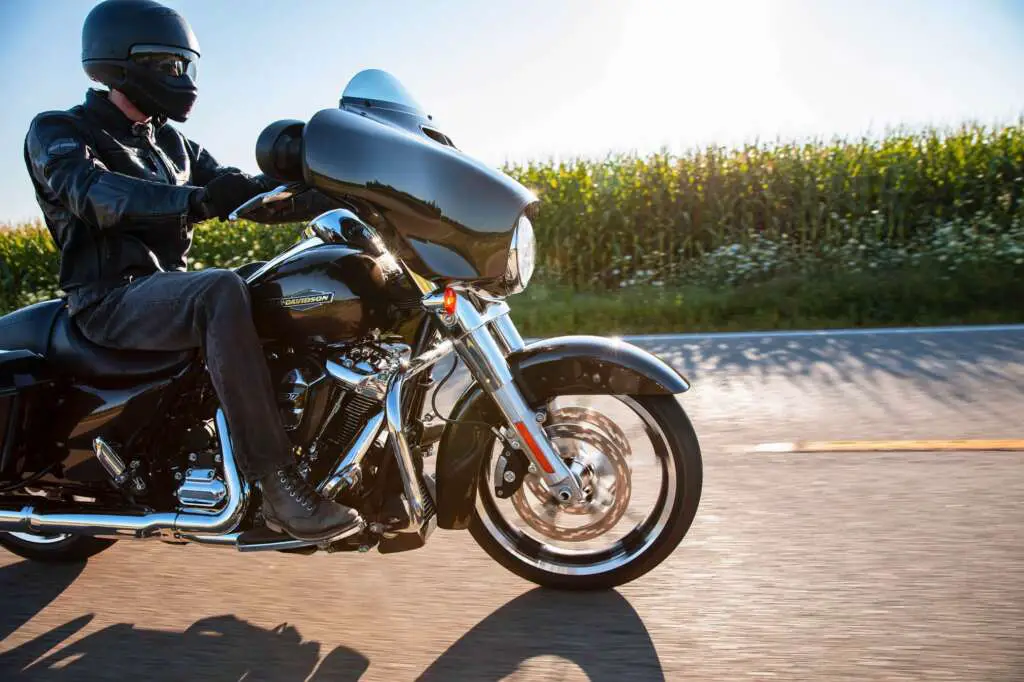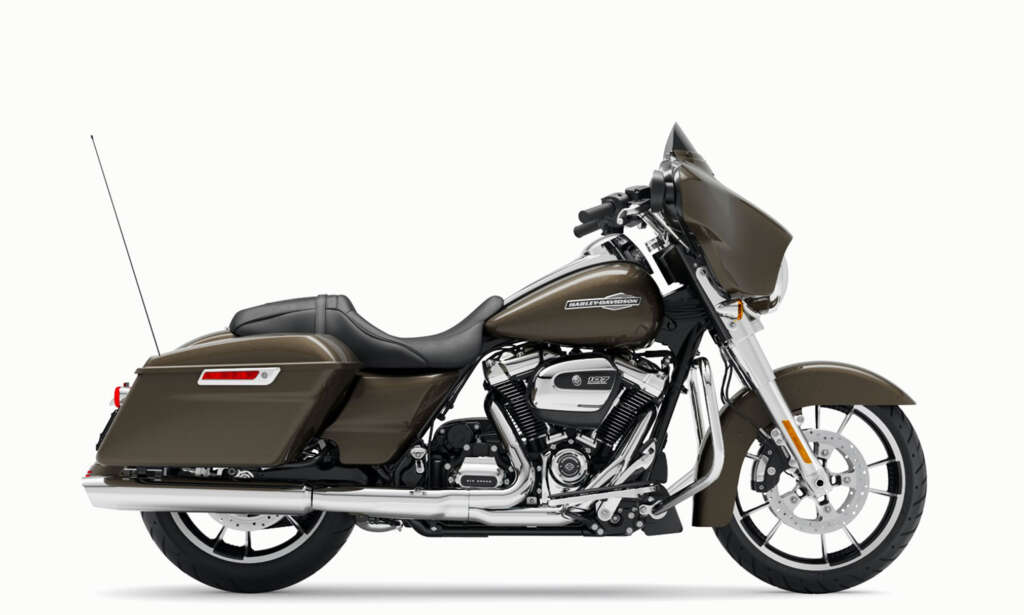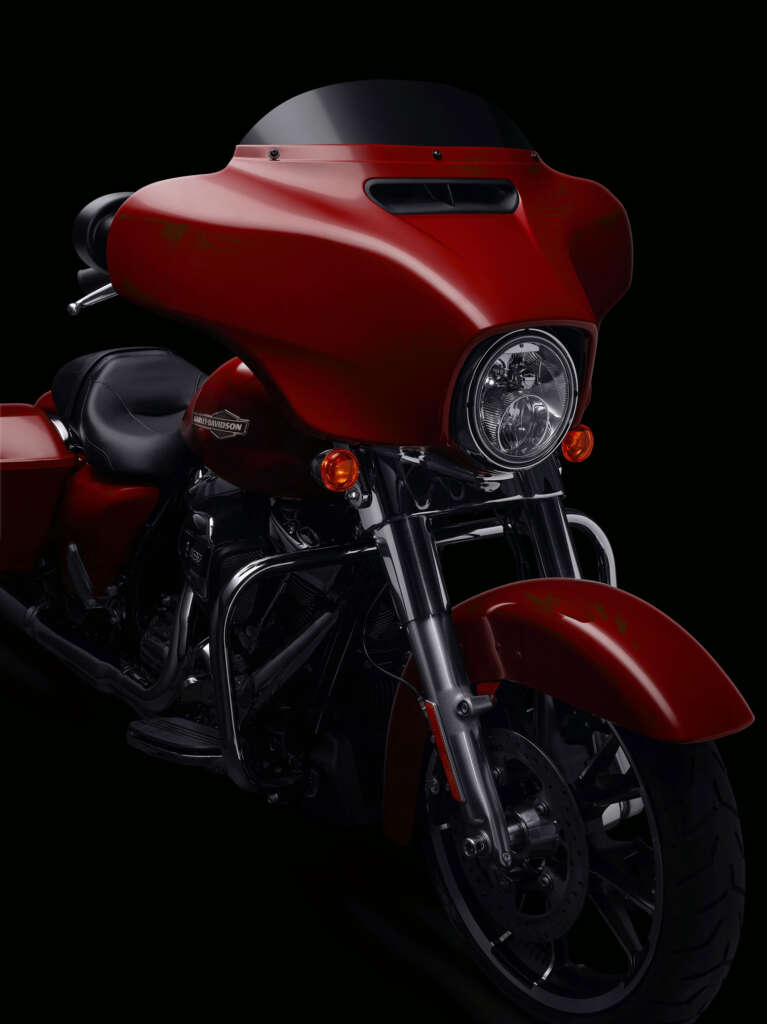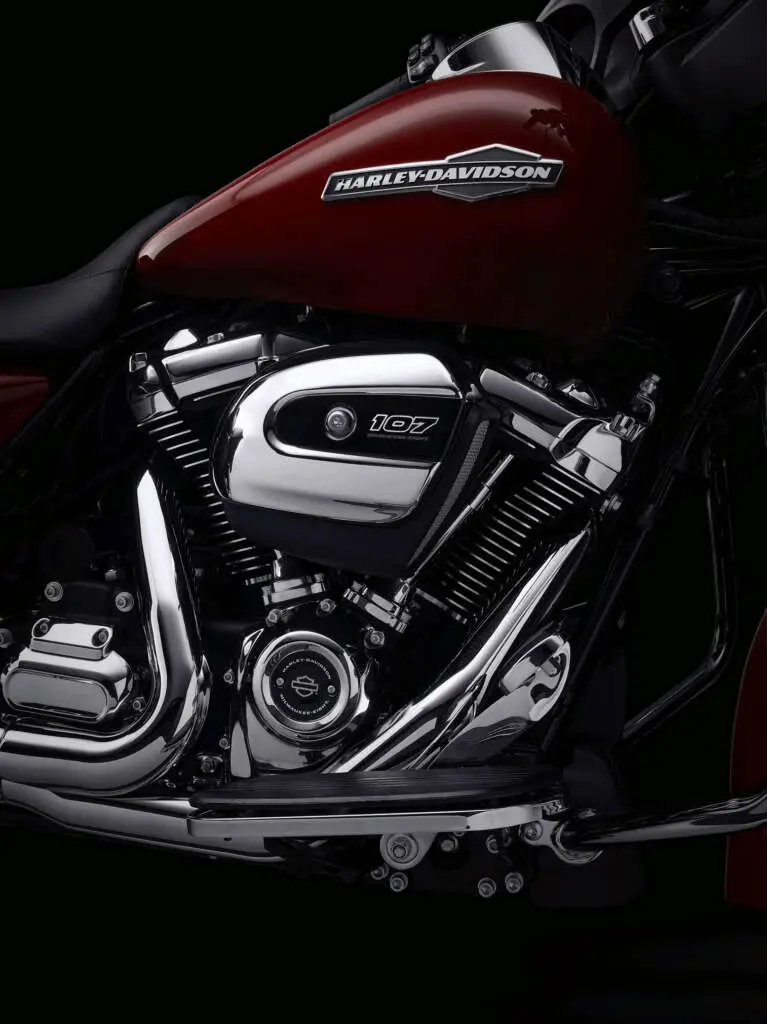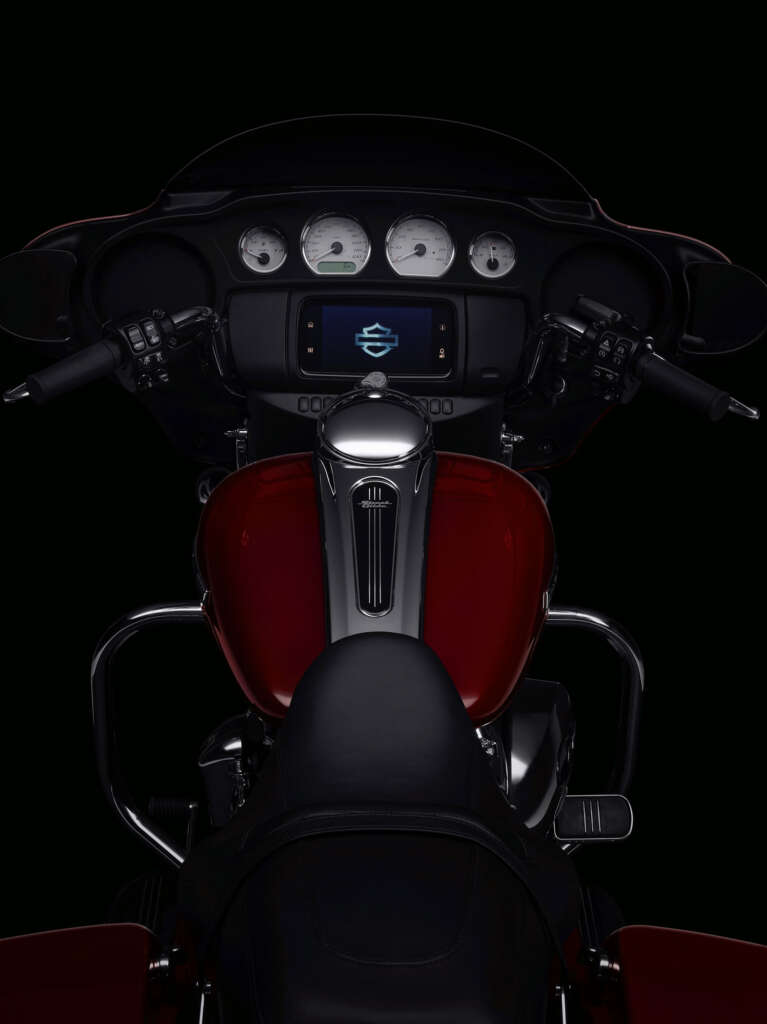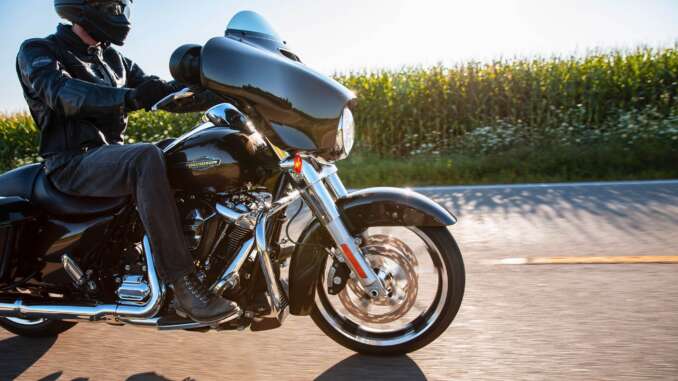
2021 Harley-Davidson Street Glide: THE ORIGINAL HOT ROD BAGGER.
Introducing the 2021 Harley-Davidson Street Glide…
The look is backed up by the refined power of a Milwaukee-Eight 107 engine and high-performance suspension for an unmatched ride. The optional RDRS Safety Enhancements is a collection of technologies designed to enhance rider confidence during unexpected situations or poor road conditions.. The systems utilize advanced chassis control, electronic brake control and powertrain technology to assist you with accelerating and braking in a straight line or while in a turn. The original stripped-down hot rod bagger.
Touring – Go the distance and discover the wide-open world in the most epic way possible.
The original stripped-down hot-rod bagger.
2021 Harley-Davidson Street Glide Totalmotorcycle.com Key Features
THIS IS THE RIGHT BIKE FOR
Riders seeking a slammed custom look
High-style in town and traveling the long road
Milwaukee-Eight® 107 V-Twin engine and batwing fairing
Upright riding position
Floorboards
Passenger seat
Saddlebags
Fork mounted fairing
Infotainment
RDRS optional
Milwaukee-Eight 114 Power
Each Special model is powered by the Milwaukee-Eight 114 V-Twin engine, the most displacement and power offered from the factory for Harley-Davidson Touring model motorcycles. In the Touring chassis, the rubber-mounted and counter-balanced Milwaukee-Eight 114 engine delivers inspiring performance and classic Harley-Davidson look-sound-feel.
- Displacement: 114 cu in (1,868 cc)
- Compression Ratio: 10.5:1
- Torque: 118 ft. lb. @ 3250 RPM
- Four valve cylinder heads (two exhaust and two intake valves per head, eight total); improved airflow through the engine contributes to power output.
- Dual spark plugs for more complete combustion of the air/fuel charge and maximized power and efficiency.
- Single camshaft reduces mechanical noise so a richer exhaust tone can predominate.
- Advanced cylinder head design, dual knock sensors, and precision cooling allow a higher compression ratio for increased torque output and strong acceleration.
- V-Twin design with 45-degree cylinder angle maintains classic Harley-Davidson look-sound-feel.
- 6-Speed Cruise Drive transmission reduces engine RPM at highway speeds to enhance fuel economy and rider comfort.
- New Ventilator high-performance air cleaner with a washable filter element improves air flow to the engine and adds performance styling.
Harley-Davidson Touring Chassis
The Harley-Davidson Touring frame is designed for the long haul, with a rigid backbone design to sustain the weight of passengers and luggage and to support current engine power.
- Front suspension with dual bending valve internal technology for linear damping performance and a smooth ride.
- Emulsion technology rear shocks are calibrated for touring and feature a single-knob pre-load adjustment that does not require tools or maintenance.
- Lowered rear suspension gives Special models a slammed stance.
- Prodigy cast-aluminum wheels (19-inch front, 18-inch rear) are exclusive to Special models.
- Standard Reflex™ Linked Brembo Brakes with ABS (Antilock Braking System) is designed to help prevent the wheels from locking under braking to assist the rider in maintaining control when braking in a straight-line. ABS operates independently on front and rear brakes to help prevent uncontrolled wheel lock in urgent situations.
- Optional RDRS Safety Enhancements (formerly known as RDRS) – A collection of technologies designed to match motorcycle performance to available traction during acceleration, deceleration and braking. Includes linked braking, ABS, traction control, drag-torque slip control, tire pressure monitoring system, and vehicle hold control.
2021 Harley-Davidson Street Glide Totalmotorcycle.com Features and Benefits
MILWAUKEE-EIGHT® 107 ENGINE
A powerful, smooth-running engine with crisp throttle response and a pure, soul-satisfying rumble.
REFLEX™ LINKED BREMBO® BRAKES WITH STANDARD ABS
Designed to help prevent the wheels from locking under braking to assist the rider in maintaining control when braking in a straight-line. ABS operates independently on front and rear brakes to keep the wheels rolling and help prevent uncontrolled wheel lock in urgent situations.
BOOM!™ BOX GTS INFOTAINMENT SYSTEM
An evolved interface experience that offers a contemporary look, feel and function, with exceptional durability and features designed specifically for motorcycling. Every element is optimized to enhance the rider’s interaction with the bike and connectivity with the world.
BATWING FAIRING
The Batwing fairing has an iconic shape with a sleek, progressive style that delivers smooth air flow and reduced head buffeting.
RESPONSIVE SUSPENSION
High-performing front and rear suspension with easily hand-adjustable rear shocks put you in control of a plush ride.
There’s a wide-open world to experience out there. We’ve been building the motorcycles to help you discover it in the most epic way possible since we invented the fully dressed touring machine in the 1960’s. Entire continents; and all the mountain ranges, canyons, glaciers, small towns, deserts, cities, roadside attractions, adventures, and stories they contain; are yours for the taking in the saddle of a Harley-Davidson Touring machine. No one builds them better.
HARLEY-DAVIDSON® RDRS SAFETY ENHANCEMENTS DESIGNED TO BOOST MOTORCYCLE RIDER CONFIDENCE
Harley-Davidson® RDRS Safety Enhancements (formerly known as RDRS) is a collection of technology designed to enhance rider confidence during unexpected situations or poor road conditions. RDRS Safety Enhancements are designed to match motorcycle performance to available traction during acceleration, deceleration and braking, in a straight line or while in a turn. The systems are electronic and utilize the latest chassis control, electronic brake control and powertrain technology.
“RDRS Safety Enhancements are technologies developed by Harley-Davidson and designed to make motorcycling more intuitive,” said VP Marketing Theo Keetell. “Our intent is to assist riders of every skill level in an unanticipated moment when electronic intervention may react more quickly, and with more precision, than our own reflexes can react. A situation that activates an RDRS Safety Enhancement may be rare, but if it occurs, this technology may be invaluable.”
Introduced for many 2020 Harley-Davidson® motorcycles, RDRS Safety Enhancements are standard on all 2021 Harley-Davidson CVO™, Tri Glide® Ultra, Freewheeler®, and LiveWire® models. RDRS Safety Enhancements are optional on all 2021 Touring models in the U.S. The RDRS Safety Enhancements are bundled together, except where noted.
Important Note: Available traction is determined by the road/tire interface. RDRS Safety Enhancements on motorcycles are only able to adjust brake pressure or powertrain torque in an attempt to keep the forces at the tire from exceeding available grip. These technologies do not have the ability to increase grip, or to intervene when the rider has not made a brake or throttle application (e.g. coasting through a corner with the clutch disengaged). RDRS Safety Enhancements on motorcycles do not have the ability to directly influence vehicle direction. This is a key difference between motorcycle RDRS Safety Enhancements and automotive stability control. The rider is ultimately responsible for speed, steering and path corrections.
Cornering Enhanced RDRS Safety Enhancements
Some RDRS Safety Enhancements may be “cornering enhanced,” technology that is motorcycle-specific and a key difference between RDRS Safety Enhancements and automotive traction/stability control systems. Harley-Davidson motorcycles equipped with RDRS Safety Enhancements have an inertial measurement unit, or IMU, that measures and reports the lean angle of two-wheel motorcycles, or the lateral acceleration of a Trike (three-wheel motorcycle), as it navigates a turn. Because many motorcycles have different size front and rear tires, when the motorcycle leans into a turn the wheels begin to rotate at slightly different speeds. The tire traction patch – the part of the tire actually touching the pavement – also changes as the motorcycle leans in a turn. Cornering enhanced technology takes this into account and for optimal performance intervenes differently when the motorcycle is leaned compared to when the motorcycle is upright.
RDRS Safety Enhancements
Cornering Enhanced Electronic Linked Braking (C-ELB)
This technology applies braking effort to both wheels when the rider uses either the hand lever (front) or foot pedal (rear) brake control, which can help many riders achieve better braking performance. The C-ELB system provides more responsiveness and allows for more balanced front and rear braking under a wide variety of brake applications. The system provides more linking when the rider is applying heavier braking and reduces or eliminates linking for light braking and low speeds. When linked, applying the front brake lever alone will cause the system to also dynamically apply an amount of braking to the rear. Applying the rear brake pedal alone will cause the system to also apply an amount of braking to the left front caliper. C-ELB takes into account the motorcycle lean angle or Trike lateral acceleration. C-ELB will alter the proportioning of brake pressure between the front and rear brakes when braking while cornering in an attempt to improve the ability of the bike to maintain the rider’s intended path.
This technology is standard on all 2020-later CVO™ models and optional on most 2020 Touring models.
Cornering Enhanced Antilock Braking System (C-ABS)
ABS is designed to prevent the wheels from locking under braking and helps the rider maintain control when braking in a straight-line, urgent situation. ABS operates independently on front and rear brakes to keep the wheels rolling and prevent uncontrolled wheel lock. Cornering Enhanced Antilock Braking System (C-ABS) is a variant of ABS that takes into consideration the lean angle of a two-wheel motorcycle, or the lateral acceleration of a Trike model. The brake pressure required to limit wheel slip when cornering is typically lower than the pressure required under straight line operation.
This technology is standard on 2020-later LiveWire and CVO models and optional on most 2020-later Touring models.
Cornering Enhanced Traction Control System (C-TCS)
The Cornering Enhanced Traction Control System (C-TCS) is designed to prevent the rear wheel from excessive spinning under acceleration when going straight or cornering. C-TCS can improve rider confidence when available traction is compromised by wet weather, a sudden unanticipated change in the surface, or when riding on an unpaved road. The rider may select one of two traction control modes: Standard Mode is optimized for dry surfaces; Rain Mode is optimized for wet surfaces. The system can also be turned off. The action of C-TCS is also tailored when cornering based on lean angle.
This technology is standard on all 2020-later LiveWire and CVO models and optional on most 2020-later Touring models.
Drag-Torque Slip Control System (DSCS)
Cornering Enhanced Drag-Torque Slip Control System (C-DSCS)
Drag-Torque Slip Control (DSCS) is designed to reduce excessive rear-wheel slip under deceleration, which typically occurs when the rider makes an abrupt down-shift gear change or decelerates abruptly on wet or slippery road surfaces. When DSCS detects excessive rear wheel slip under deceleration it will adjust engine torque delivery to better match rear-wheel speed to road speed. On models equipped with C-DSCS the action of DSCS may be tailored when cornering, based on detected lean angle (two-wheel motorcycles) or lateral acceleration (Trike models).
DSCS is standard on all 2020-later CVO models and optional on most 2020-later Touring models. C-DSCS is standard on all 2020-later Trike models.
Vehicle Hold Control (VHC)
Vehicle Hold Control (VHC) applies and holds brake pressure when activated and prevents the motorcycle from rolling after the rider has released the brake controls. The primary function of VHC is to prevent the motorcycle from rolling when it is stopped, for example at a stop sign on a hill, in stop-and-go traffic on a slope, or on a steep decline out of a parking structure. VHC is designed to make it easier to ride away with confidence by minimizing the number of controls needed to pull away smoothly. The system applies brake pressure until the rider actuates the throttle and clutch to pull away. VHC may also be engaged when the motorcycle is stopped on a flat surface if the rider wants to maintain position without applying pressure to a brake control.
The rider activates VHC by momentarily applying extra pressure to either the front-brake hand lever or the rear-brake foot control after the motorcycle has come to a complete stop. If rider brakes very hard to a stop, and holds the brake pressure after stopping, VHC may also set without any added squeeze. A VHC indicator light will illuminate to confirm that the rider has activated VHC, and the ABS system will hold brake pressure after the rider releases the brake control. VHC is disengaged automatically as the rider begins to pull away from a stop, or if the rider applies and releases either brake control.
VHC is not to be used as a parking brake, so it will also disengage if the rider lowers the side stand (on models with a side-stand sensor, not a feature in all markets) or shifts into neutral on models without a side-stand sensor, or if the engine is turned off. In most situations after five minutes the indicator light will flash and the VHC will release if there is no rider action.
This feature is standard on 2020-later CVO™ models and optional on most 2020-later Touring models. VHC is not intended as a substitute for a parking brake in any situation.
Tire Pressure Monitoring System (TPMS)
TPMS alerts the rider to low tire air pressure. Maintaining proper tire air pressure is important both for vehicle performance and tire life. The TPMS displays current front and rear tire pressure on the Boom!™ Box GTS screen (or on the odometer on Road King® models) and displays an indicator to alert the rider when tire pressure is low, and the pressure should be checked.
TPMS is part of the collection of RDRS Safety Enhancements and is also available as a stand-alone accessory through Harley-Davidson® Genuine Motor Parts & Accessories for 2020-later Touring models (except Japan) equipped with original equipment or accessory wheels that accept a TPMS sensor.
RDRS Safety Enhancements for Trike Models
Harley-Davidson® Freewheeler® and Tri Glide® Ultra models are equipped with Trike-specific RDRS Safety Enhancements. These include Cornering Enhanced Electronic Linked Braking (C-ELB), Cornering Enhanced ABS (C-ABS), Cornering Enhanced Traction Control System (C-TCS) and Cornering Enhanced Drag-Torque Slip Control System (C-DSCS). The CVO™ Tri Glide® model adds TPMS to the Trike-specific RDRS Safety Enhancements.
2021 Harley-Davidson Street Glide – Totalmotorcycle.com Specifications/Technical Details
US MSRP Price: $21999 to $22499 USD
Canada MSRP Price: $26999 to 27599 CDN
Europe/UK MSRP Price: £ NA GBP (On The Road inc 20% Vat)
USA PRICING
VIVID BLACK
$21,999
COLOR
$22,499
ABS OPTION
Standard
REFLEX™ DEFENSIVE RIDER SYSTEM (RDRS)
$995
SECURITY OPTION
Standard
CRUISE CONTROL OPTION
Standard
PREMIUM RADIO OPTION
$895
CALIFORNIA EMISSIONS
$200
FREIGHT
$435
Canadian PRICING
VIVID BLACK
$26,999
COLOUR
$27,599
ABS OPTION
Standard
REFLEX™ DEFENSIVE RIDER SYSTEM (RDRS) OPTION
$900
SECURITY OPTION
Standard
CRUISE CONTROL OPTION
Standard
PREMIER RADIO OPTION
Standard
| Model | FLHX Street Glide® | Notes |
| Dimensions | ||
| Length | 96.5 in. (2,450 mm) | |
| Overall Width | 37.8 in. (960 mm) | |
| Overall Height | 53.1 in. (1,350 mm) | |
| Seat Height, Laden | 26.1 in. (664 mm) | 2 |
| Seat Height, Unladen | 27.4 in. (695 mm) | |
| Ground Clearance | 5.3 in. (135 mm) | |
| Rake (steering head) (deg) | 26 | |
| Fork Angle (deg) | 29.25 | |
| Trail | 6.7 in. (170 mm) | |
| Wheelbase | 64 in. (1,625 mm) | |
| Tires, Type | Dunlop® Harley-Davidson Series, bias blackwall front and rear | |
| Tires, Front Model | D408F | |
| Tires, Front Specification | 130/60B19 61H | |
| Tires, Rear Model | D407T | |
| Tires, Rear Specification | BW 180/55B18 80H | |
| Fuel Capacity | 6 gal. (22.7 l) | |
| Reserve Fuel Capacity, Fuel Injection (warning light) | 1 gal. (3.8 l) | |
| Oil Capacity (w/filter) | 5.2 qt. (4.9 l) | |
| Transmission Capacity | 1 qt. (.95 l) | |
| Primary Chain Case Capacity | 1.1 qts. (1 l) | |
| Coolant Capacity | N/A | |
| Weight, As Shipped | 796 lb. (361 kg) | |
| Weight, In Running Order | 829 lb. (376 kg) | |
| Gross Vehicle Weight Rating | 1,360 lb. (617 kg) | |
| Gross Axle Weight Rating, Front | 500 lb. (227 kg) | |
| Gross Axle Weight Rating, Rear | 927 lb. (420 kg) | |
| Luggage Capacity -Volume | 2.3 cu ft (0.064 m3) | |
| Engine | ||
| Engine | Milwaukee-Eight® 107 | |
| Valves | Pushrod-operated, overhead valves with hydraulic, self-adjusting lifters; four valves per cylinder | |
| Bore | 3.937 in. (100 mm) | |
| Stroke | 4.375 in. (111 mm) | |
| Displacement | 107 cu in (1,746 cc) | |
| Compression Ratio | 10.0:1 | |
| Fuel System | Electronic Sequential Port Fuel Injection (ESPFI) | 3 |
| Air Cleaner | Paper, washable | |
| Exhaust | Chrome, 2-1-2 dual exhaust with tapered mufflers | |
| Lubrication System | Pressurized, dry-sump with oil cooler | |
| Drivetrain | ||
| Primary Drive | Chain, 34/46 ratio | |
| Final Drive | Belt, 32/68 ratio | |
| Clutch | Mechanically actuated 10 plate wet, Assist and Slip | |
| Transmission | 6-Speed Cruise Drive® | |
| Gear Ratios (overall) 1st | 9.593 | |
| Gear Ratios (overall) 2nd | 6.65 | |
| Gear Ratios (overall) 3rd | 4.938 | |
| Gear Ratios (overall) 4th | 4 | |
| Gear Ratios (overall) 5th | 3.407 | |
| Gear Ratios (overall) 6th | 2.875 | |
| Chassis | ||
| Frame | Mild steel; tubular frame; two-piece stamped and welded backbone; cast and forged junctions; twin downtubes; bolt-on rear frame with forged fender supports; MIG welded. | |
| Swingarm | Mild steel; two-piece drawn and welded section; forged junctions; MIG welded. | |
| Front Fork | 49mm Dual Bending Valve | |
| Rear Shocks | Premium Low Hand-Adjustable Rear Suspension | |
| Wheels, Front Type | Enforcer II Cast Aluminum | 4 |
| Wheels, Front Width | 3.5 in. (89 mm) | |
| Wheels, Front Height | 19 in. (483 mm) | |
| Wheels, Rear Type | Enforcer II Cast Aluminum | 4 |
| Wheels, Rear Width | 5 in. (127 mm) | |
| Wheels, Rear Height | 18 in. (457 mm) | |
| Brakes, Caliper Type | 32 mm, 4-piston fixed front and rear | |
| Brakes, Rotor Type | Dual floating rotors (front), fixed rotor (rear) | |
| Brakes, Front Diameter | 11.8 in. (300 mm) | |
| Brakes, Front Thickness | 0.2 in. (5.1 mm) | |
| Brakes, Front is dual | Yes | |
| Brakes, Rear Diameter | 11.8 in. (300 mm) | |
| Brakes, Rear Thickness | 0.28 in. (7.1 mm) | |
| Brakes, Anti-Lock Braking System (ABS) | Standard | |
| Suspension Travel, Front | 4.6 in. (117 mm) | |
| Suspension Travel, Rear | 2.1 in. (54 mm) | |
| Performance | ||
| Engine Torque Testing Method | J1349 | |
| Engine Torque | 111 ft-lb (151 Nm) | 5 |
| Engine Torque (rpm) | 3,250 | |
| Lean Angle Testing Method | J1168 | |
| Lean Angle, Right (deg.) | 31 | |
| Lean Angle, Left (deg.) | 29 | |
| Fuel Economy Testing Method | Estimated City/Hwy | |
| Fuel Economy | 43 mpg (5.5 l/100 km) | 6 |
| Electric | ||
| Battery | Sealed, maintenance-free, 12V, 28-amp/hour, 405 cca (per Battery Council International Rating) | |
| Charging | Three-phase, 48-amp system (600W @ 13V, 2000 rpm, 625W max power @ 13V) | |
| Starting | 1.6 kW electric with solenoid shift starter motor engagement | |
| Lights (as per country regulation), Headlamp | Dual halogen headlight 55-watt 625 lumen low beam, 65-watt 1,570 high beam | |
| Lights (as per country regulation), Tail/Stop | 8W/28W | |
| Lights (as per country regulation), Front Signal Lights | 8W/28W | |
| Lights (as per country regulation), Indicator Lamps | High beam, running lights, directional lights, low oil pressure, engine diagnostics, neutral, cruise control, speakers, accessory, battery, gear indication, security system, 6-speed, low fuel warning, ABS, miles to empty display, fog/aux lamp indicator | 7 |
| Lights, Rear Turn Signals | ||
| Gauges | Gauges styled to complement each vehicle. Display features odometer, trip A, trip B, range to empty and gear indicator; and larger tell-tale indicators. | |
| Auxiliary Lamps | N/A | |
| Electric Power Outlet | Electric power accessory port in fairing | |
| GPS System | N/A | |
| Reverse Gear | N/A | |
| Warranty And Service | ||
| Warranty | 24 months (unlimited mileage) | 8 |
| Service Interval | First 1,000 miles (1,600 km), every 5,000 miles (8,000 km) thereafter | 9 |
Footnotes1Vehicles depicted may differ from vehicles manufactured and delivered. Specifications and prices listed may differ from specifications and prices of vehicles manufactured and delivered. All product descriptions (including depictions, specifications, dimensions, measurements, ratings and competitive comparisons) are based on available information at the time of publication. Although such descriptions are believed correct, errors and changes can occur and complete accuracy cannot be guaranteed. Harley-Davidson may make changes at any time to prices and specifications, and may change or discontinue models, without notice and without incurring any obligation. Attention: Vehicles in the configurations shown and many of the accessories described in this catalog may not be available for sale or use in some locations. Please check with your dealer for complete product details and the latest information. All models feature 6-speed transmission (VRSC™ models and Sportster® models are 5-speed) and carbon fiber belt final drive; multi-plate clutch with diaphragm spring in oil bath; and 2-year unlimited mileage warranty. 2Measurement reflects 180 lb. (81.7 kg) operator weight. 3Recommended 91 octane or higher fuel (R+M)/2. 4Standard and optional wheels may vary by country and region. 5Values shown are nominal. Performance may vary by country and region. 6The combined fuel economy numbers were derived using a combination of estimated city and highway values. Fuel economy estimates are derived from US EPA exhaust emission certification data on a sample motorcycle from the corresponding family under ideal laboratory conditions. Your actual fuel economy will vary depending on your personal riding habits, road and driving conditions, vehicle condition and maintenance, tire pressure, vehicle configuration (parts and accessories), and vehicle loading (cargo, rider and passenger weight). Break-in mileage may vary. 7North America security system includes immobilizer; outside North America the security system includes immobilizer and siren. 8See motorcycle owner’s manual for complete details. 9Inspections of certain systems and components are required at 2,500 mile (4,000 km) intervals. See Owner’s Manual for full details.
Manufacturer Specifications and appearance are subject to change without prior notice on Total Motorcycle (TMW).


